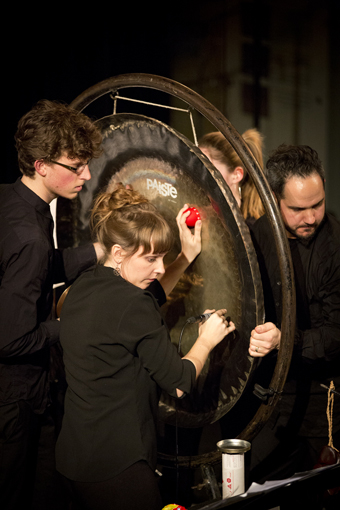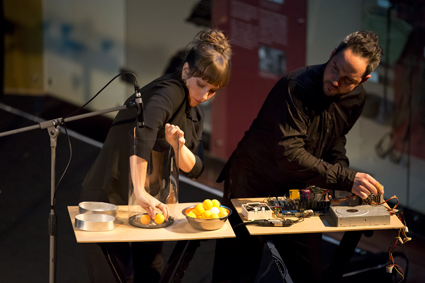Explorers of an alien planet
John Barton: Speak Percussion, Robin Fox, Transducer

Mickrophonie I, Transducer, Speak Percussion, THNMF2013
photo Brad Serls
Mickrophonie I, Transducer, Speak Percussion, THNMF2013
Featuring the world premiere of Robin Fox and Eugene Ughetti’s Transducer in conjunction with Karlheinz Stockhausen’s seminal work, Mikrophonie I, the West Australian Museum’s Hackett Hall was transformed into an enclave of fantastical sound worlds that shook up even the most stubborn ears.
Transducer is a work almost entirely devoid of instruments in the traditional sense. Sticks, ping-pong balls and coins are used to instigate acoustic events for which microphones act as receptors. These events are then spatialised and manipulated around the hall through eight speakers, projecting sounds almost alien from their original source. The spectacular players of Speak Percussion perform the work with great dedication, as their bodies become integrated into the piece, with microphones picking up their movements and transmitting them into the electronic sound world.
With direct references to Reich and Cage, Transducer is a work more about playing within the electrical sound space than precise reproduction. Hisses and spits of feedback comprise the core soundscape, which is manipulated with expertise by Robin Fox, creating dynamic sound events. The piece evokes moments of harmonic beauty, especially when sine wave tones are emitted from different speakers that are “played” as microphones are randomly swung over them. At other moments, all turns to cacophony, and one is transported into huge sound worlds of electric currents crashing against one another, disrupting and dispersing in a display of uncontrollable power.

Leah Scholes, Eugene Ughetti, Transducer, Speak Percussion, THNMF2013
photo Brad Serls
Leah Scholes, Eugene Ughetti, Transducer, Speak Percussion, THNMF2013
While Transducer manages to create moments of wonderment in tensions between pure and static sound environments, it is not without its weaknesses. The performance is often reduced to novelty, as performers seem to move from one idea to another with seemingly little relation to each other. While improvisation is integral to a work like this, it can also diminish the overall effect. Nonetheless, this was a bold and powerful work.
An early work in his oeuvre, Karlheinz Stockhausen’s Mikrophonie I (1964), is for tam-tam with four players scratching and scraping its surface. These sounds are then picked up by handheld microphones and beamed out through speakers situated around the ghostly expanse of Hackett Hall. The players “speak”, either with their voices or with various shapes of cups, tubes and even children’s toys, into the tam-tam. Communicating with each other, sometimes in harmony, at other times in conflict, the players negotiate the tam-tam’s metallic surface like explorers of an alien planet.
The performance by Speak Percussion was profound, as they communicated with each other with soul-bearing intimacy through the surface of the tam-tam. In a work that requires communal agreement not only in performance, but also in deciding the order in which the piece is played (the score allows for multiple approaches), Speak Percussion showed their ability to perform not only as phenomenal soloists but as a group that is able to negotiate complex sound worlds.






